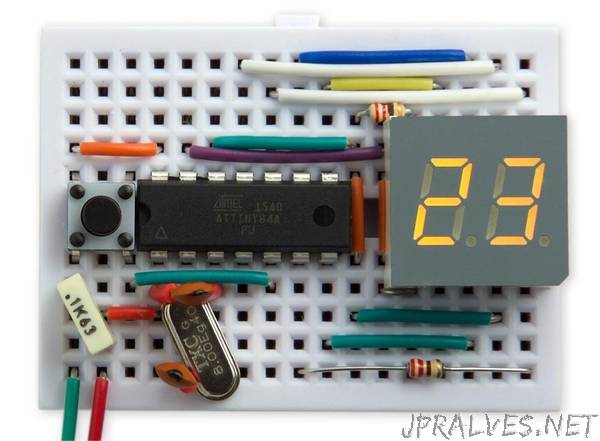
“There seems to be a lot of discussion in the news currently about how much alcohol it’s safe to drink on a regular basis [1][2]. If you want help in monitoring your alcohol consumption this gadget might be useful. You enter the number of units you drink each day, and it keeps track of where you are relative to your target intake:
It’s based on a low-cost two-digit LED display and an ATtiny84.
Introduction
I built this circuit a while ago when I wanted a way to keep an eye on my alcohol intake. Of course you could achieve the same result with a calendar and notebook, but this is more fun and motivating. The aim is to keep to a sensible average level of consumption, with the ability to enjoy several drinks when the occasion arises.
Using the Alcohol Unit Counter
The Alcohol Unit Counter helps you keep to the UK recommended maximum adult alcohol intake of 14 units a week, ie two units a day (you can change this in the program).
To use it press the button once to display your current position relative to your target alcohol consumption; the aim is to keep this at zero.
For example, if it shows 0 you’re on target, 2 means you’re 2 units over and you’ll need to have an alcohol-free day to catch up, and -4 means you’re under target and you can enjoy half a bottle of wine, and so on.
At the end of the evening press the button again to enter each unit you’ve consumed, and the counter increments accordingly. In the middle of the night the counter automatically decrements by your daily allowance.
The counter can display between -19 and 39. Beyond this range it displays ” for less than -19 or ‘^^’ for more than 39. To save power the display blanks automatically after four seconds.
Calculating units
If you don’t know how to work out the number of units in a drink here’s the method: simply multiply the volume in litres by the percentage alcohol content. So, a 75cl bottle of 12% alcohol wine contains 0.75x12 or 9 units, and a 500ml bottle of 5% beer contains 0.5x5 or 2.5 units. If you’re working in pints you can roughly divide the number of pints by 2 to get litres.”
